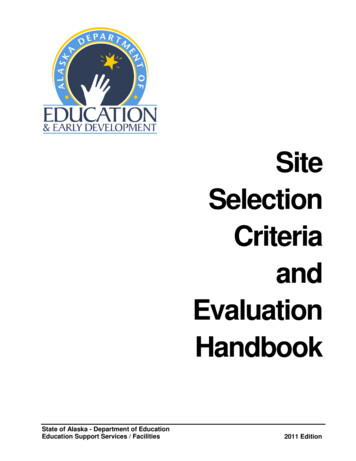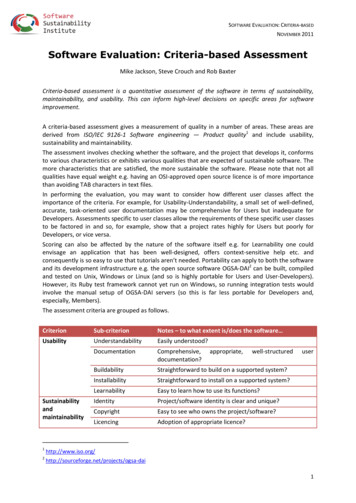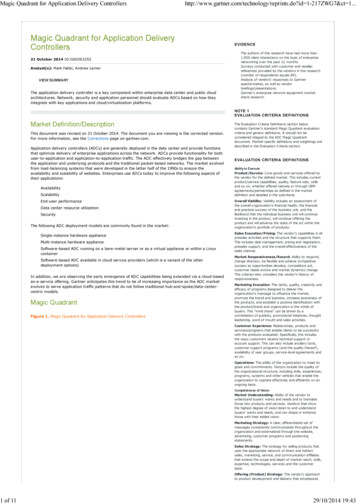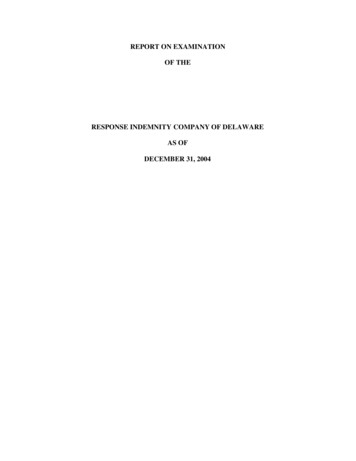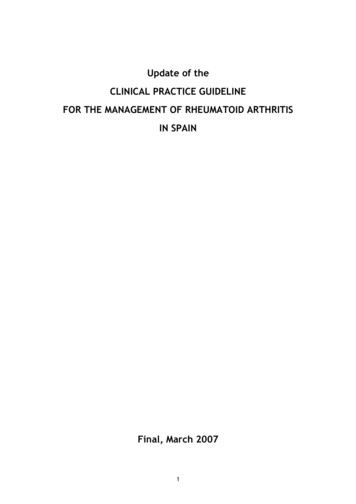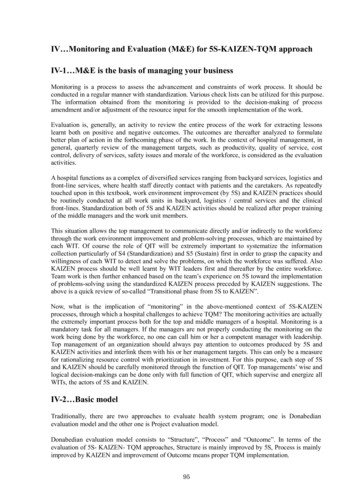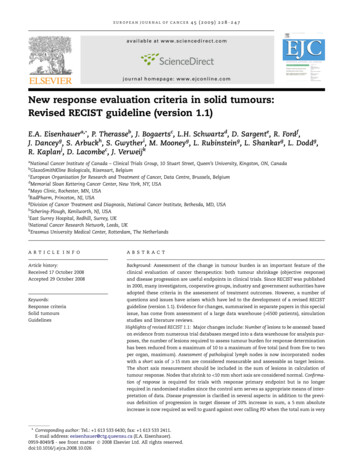
Transcription
EUROPEAN JOURNAL OF CANCER4 5 ( 2 0 0 9 ) 2 2 8 –2 4 7available at www.sciencedirect.comjournal homepage: www.ejconline.comNew response evaluation criteria in solid tumours:Revised RECIST guideline (version 1.1)E.A. Eisenhauera,*, P. Therasseb, J. Bogaertsc, L.H. Schwartzd, D. Sargente, R. Fordf,J. Danceyg, S. Arbuckh, S. Gwytheri, M. Mooneyg, L. Rubinsteing, L. Shankarg, L. Doddg,R. Kaplanj, D. Lacombec, J. VerweijkaNational Cancer Institute of Canada – Clinical Trials Group, 10 Stuart Street, Queen’s University, Kingston, ON, CanadaGlaxoSmithKline Biologicals, Rixensart, BelgiumcEuropean Organisation for Research and Treatment of Cancer, Data Centre, Brussels, BelgiumdMemorial Sloan Kettering Cancer Center, New York, NY, USAeMayo Clinic, Rochester, MN, USAfRadPharm, Princeton, NJ, USAgDivision of Cancer Treatment and Diagnosis, National Cancer Institute, Bethesda, MD, USAhSchering-Plough, Kenilworth, NJ, USAiEast Surrey Hospital, Redhill, Surrey, UKjNational Cancer Research Network, Leeds, UKkErasmus University Medical Center, Rotterdam, The NetherlandsbA R T I C L E I N F OA B S T R A C TArticle history:Background: Assessment of the change in tumour burden is an important feature of theReceived 17 October 2008clinical evaluation of cancer therapeutics: both tumour shrinkage (objective response)Accepted 29 October 2008and disease progression are useful endpoints in clinical trials. Since RECIST was publishedin 2000, many investigators, cooperative groups, industry and government authorities haveadopted these criteria in the assessment of treatment outcomes. However, a number ofKeywords:questions and issues have arisen which have led to the development of a revised RECISTResponse criteriaguideline (version 1.1). Evidence for changes, summarised in separate papers in this specialSolid tumoursissue, has come from assessment of a large data warehouse ( 6500 patients), simulationGuidelinesstudies and literature reviews.Highlights of revised RECIST 1.1: Major changes include: Number of lesions to be assessed: basedon evidence from numerous trial databases merged into a data warehouse for analysis purposes, the number of lesions required to assess tumour burden for response determinationhas been reduced from a maximum of 10 to a maximum of five total (and from five to twoper organ, maximum). Assessment of pathological lymph nodes is now incorporated: nodeswith a short axis of P15 mm are considered measurable and assessable as target lesions.The short axis measurement should be included in the sum of lesions in calculation oftumour response. Nodes that shrink to 10 mm short axis are considered normal. Confirmation of response is required for trials with response primary endpoint but is no longerrequired in randomised studies since the control arm serves as appropriate means of interpretation of data. Disease progression is clarified in several aspects: in addition to the previous definition of progression in target disease of 20% increase in sum, a 5 mm absoluteincrease is now required as well to guard against over calling PD when the total sum is very* Corresponding author: Tel.: 1 613 533 6430; fax: 1 613 533 2411.E-mail address: eeisenhauer@ctg.queensu.ca (E.A. Eisenhauer).0959-8049/ - see front matter 2008 Elsevier Ltd. All rights reserved.doi:10.1016/j.ejca.2008.10.026
EUROPEAN JOURNAL OF CANCER4 5 ( 2 0 0 9 ) 2 2 8 –2 4 7229small. Furthermore, there is guidance offered on what constitutes ‘unequivocal progression’ of non-measurable/non-target disease, a source of confusion in the original RECISTguideline. Finally, a section on detection of new lesions, including the interpretation ofFDG-PET scan assessment is included. Imaging guidance: the revised RECIST includes anew imaging appendix with updated recommendations on the optimal anatomical assessment of lesions.Future work: A key question considered by the RECIST Working Group in developing RECIST1.1 was whether it was appropriate to move from anatomic unidimensional assessment oftumour burden to either volumetric anatomical assessment or to functional assessmentwith PET or MRI. It was concluded that, at present, there is not sufficient standardisationor evidence to abandon anatomical assessment of tumour burden. The only exception tothis is in the use of FDG-PET imaging as an adjunct to determination of progression. Asis detailed in the final paper in this special issue, the use of these promising newerapproaches requires appropriate clinical validation studies. 2008 Elsevier Ltd. All rights reserved.1.Background1.1.History of RECIST criteriaAssessment of the change in tumour burden is an importantfeature of the clinical evaluation of cancer therapeutics. Bothtumour shrinkage (objective response) and time to the development of disease progression are important endpoints incancer clinical trials. The use of tumour regression as theendpoint for phase II trials screening new agents for evidence of anti-tumour effect is supported by years of evidence suggesting that, for many solid tumours, agentswhich produce tumour shrinkage in a proportion of patientshave a reasonable (albeit imperfect) chance of subsequentlydemonstrating an improvement in overall survival or othertime to event measures in randomised phase III studies (reviewed in [1–4]). At the current time objective response carries with it a body of evidence greater than for any otherbiomarker supporting its utility as a measure of promisingtreatment effect in phase II screening trials. Furthermore,at both the phase II and phase III stage of drug development,clinical trials in advanced disease settings are increasinglyutilising time to progression (or progression-free survival)as an endpoint upon which efficacy conclusions are drawn,which is also based on anatomical measurement of tumoursize.However, both of these tumour endpoints, objective response and time to disease progression, are useful only ifbased on widely accepted and readily applied standard criteria based on anatomical tumour burden. In 1981 the WorldHealth Organisation (WHO) first published tumour responsecriteria, mainly for use in trials where tumour response wasthe primary endpoint. The WHO criteria introduced the concept of an overall assessment of tumour burden by summingthe products of bidimensional lesion measurements anddetermined response to therapy by evaluation of change frombaseline while on treatment.5 However, in the decades thatfollowed their publication, cooperative groups and pharmaceutical companies that used the WHO criteria often ‘modified’ them to accommodate new technologies or to addressareas that were unclear in the original document. This ledto confusion in interpretation of trial results6 and in fact,the application of varying response criteria was shown to leadto very different conclusions about the efficacy of the sameregimen.7 In response to these problems, an InternationalWorking Party was formed in the mid 1990s to standardiseand simplify response criteria. New criteria, known as RECIST(Response Evaluation Criteria in Solid Tumours), were published in 2000.8 Key features of the original RECIST includedefinitions of minimum size of measurable lesions, instructions on how many lesions to follow (up to 10; a maximumfive per organ site), and the use of unidimensional, ratherthan bidimensional, measures for overall evaluation of tumour burden. These criteria have subsequently been widelyadopted by academic institutions, cooperative groups, andindustry for trials where the primary endpoints are objectiveresponse or progression. In addition, regulatory authoritiesaccept RECIST as an appropriate guideline for theseassessments.1.2.Why update RECIST?Since RECIST was published in 2000, many investigators haveconfirmed in prospective analyses the validity of substitutingunidimensional for bidimensional (and even three-dimensional)-based criteria (reviewed in [9]). With rare exceptions(e.g. mesothelioma), the use of unidimensional criteria seemsto perform well in solid tumour phase II studies.However, a number of questions and issues have arisenwhich merit answers and further clarity. Amongst theseare whether fewer than 10 lesions can be assessed withoutaffecting the overall assigned response for patients (or theconclusion about activity in trials); how to apply RECIST inrandomised phase III trials where progression, not response,is the primary endpoint particularly if not all patients havemeasurable disease; whether or how to utilise newer imaging technologies such as FDG-PET and MRI; how to handleassessment of lymph nodes; whether response confirmationis truly needed; and, not least, the applicability of RECIST intrials of targeted non-cytotoxic drugs. This revision of theRECIST guidelines includes updates that touch on all thesepoints.
2301.3.EUROPEAN JOURNAL OF CANCERProcess of RECIST 1.1 developmentThe RECIST Working Group, consisting of clinicians withexpertise in early drug development from academic researchorganisations, government and industry, together with imaging specialists and statisticians, has met regularly to set theagenda for an update to RECIST, determine the evidenceneeded to justify the various changes made, and to reviewemerging evidence. A critical aspect of the revision processwas to create a database of prospectively documented solidtumour measurement data obtained from industry and academic group trials. This database, assembled at the EORTCData Centre under the leadership of Jan Bogaerts and PatrickTherasse (co-authors of this guideline), consists of 6500 patients with 18,000 target lesions and was utilised to investigate the impact of a variety of questions (e.g. number oftarget lesions required, the need for response confirmation,and lymph node measurement rules) on response and progression-free survival outcomes. The results of this work,which after evaluation by the RECIST Working Group led tomost of the changes in this revised guideline, are reportedin detail in a separate paper in this special issue.10 Larry Schwartz and Robert Ford (also co-authors of this guideline) alsoprovided key databases from which inferences have beenmade that inform these revisions.11The publication of this revised guideline is believed to betimely since it incorporates changes to simplify, optimiseand standardise the assessment of tumour burden in clinicaltrials. A summary of key changes is found in Appendix I. Because the fundamental approach to assessment remainsgrounded in the anatomical, rather than functional, assessment of disease, we have elected to name this version RECIST1.1, rather than 2.0.1.4.What about volumetric or functional assessment?This raises the question, frequently posed, about whether it is‘time’ to move from anatomic unidimensional assessment oftumour burden to either volumetric anatomical assessmentor to functional assessment (e.g. dynamic contrast enhancedMRI or CT or (18)F-fluorodeoxyglucose positron emissiontomographic (FDG-PET) techniques assessing tumour metabolism). As can be seen, the Working Group and particularlythose involved in imaging research, did not believe that thereis at present sufficient standardisation and widespread availability to recommend adoption of these alternative assessment methods. The only exception to this is in the use ofFDG-PET imaging as an adjunct to determination of progression, as described later in this guideline. As detailed in paperin this special issue12, we believe that the use of these promising newer approaches (which could either add to or substitutefor anatomical assessment as described in RECIST) requiresappropriate and rigorous clinical validation studies. This paper by Sargent et al. illustrates the type of data that will beneeded to be able to define ‘endpoints’ for these modalitiesand how to determine where and when such criteria/modalities can be used to improve the reliability with which trulyactive new agents are identified and truly inactive new agentsare discarded in comparison to RECIST criteria in phase IIscreening trials. The RECIST Working Group looks forward4 5 ( 2 0 0 9 ) 2 2 8 –2 4 7to such data emerging in the next few years to allow theappropriate changes to the next iteration of the RECISTcriteria.2.Purpose of this guidelineThis guideline describes a standard approach to solid tumourmeasurement and definitions for objective assessment ofchange in tumour size for use in adult and paediatric cancerclinical trials. It is expected these criteria will be useful in alltrials where objective response is the primary study endpoint,as well as in trials where assessment of stable disease, tumour progression or time to progression analyses are undertaken, since all of these outcome measures are based on anassessment of anatomical tumour burden and its change onstudy. There are no assumptions in this paper about the proportion of patients meeting the criteria for any of these endpoints which will signal that an agent or treatment regimen isactive: those definitions are dependent on type of cancer inwhich a trial is being undertaken and the specific agent(s) under study. Protocols must include appropriate statistical sections which define the efficacy parameters upon which thetrial sample size and decision criteria are based. In additionto providing definitions and criteria for assessment of tumourresponse, this guideline also makes recommendationsregarding standard reporting of the results of trials that utilisetumour response as an endpoint.While these guidelines may be applied in malignant braintumour studies, there are also separate criteria published forresponse assessment in that setting.13 This guideline is not intended for use for studies of malignant lymphoma sinceinternational guidelines for response assessment in lymphoma are published separately.14Finally, many oncologists in their daily clinical practice follow their patients’ malignant disease by means of repeatedimaging studies and make decisions about continued therapyon the basis of both objective and symptomatic criteria. It isnot intended that these RECIST guidelines play a role in thatdecision making, except if determined appropriate by thetreating oncologist.3.Measurability of tumour at baseline3.1.DefinitionsAt baseline, tumour lesions/lymph nodes will be categorisedmeasurable or non-measurable as follows:3.1.1.MeasurableTumour lesions: Must be accurately measured in at least onedimension (longest diameter in the plane of measurement isto be recorded) with a minimum size of: 10 mm by CT scan (CT scan slice thickness no greater than5 mm; see Appendix II on imaging guidance). 10 mm caliper measurement by clinical exam (lesionswhich cannot be accurately measured with calipers shouldbe recorded as non-measurable). 20 mm by chest X-ray.
EUROPEAN JOURNAL OF CANCERMalignant lymph nodes: To be considered pathologically enlarged and measurable, a lymph node must be P15 mm inshort axis when assessed by CT scan (CT scan slice thicknessrecommended to be no greater than 5 mm). At baseline and infollow-up, only the short axis will be measured and followed(see Schwartz et al. in this Special Issue15). See also notes below on ‘Baseline documentation of target and non-target lesions’ for information on lymph node measurement.3.1.2.Non-measurableAll other lesions, including small lesions (longest diameter 10 mm or pathological lymph nodes with P10 to 15 mmshort axis) as well as truly non-measurable lesions. Lesionsconsidered truly non-measurable include: leptomeningeal disease, ascites, pleural or pericardial effusion, inflammatorybreast disease, lymphangitic involvement of skin or lung,abdominal masses/abdominal organomegaly identified byphysical exam that is not measurable by reproducible imagingtechniques.3.1.3.Special considerations regarding lesion measurabilityBone lesions, cystic lesions, and lesions previously treatedwith local therapy require particular comment:Bone lesions:. Bone scan, PET scan or plain films are not considered adequate imaging techniques to measure bone lesions. However, these techniques can be used to confirm thepresence or disappearance of bone lesions. Lytic bone lesions or mixed lytic-blastic lesions, with identifiable soft tissue components, that can be evaluated by crosssectional imaging techniques such as CT or MRI can be considered as measurable lesions if the soft tissue componentmeets the definition of measurability described above. Blastic bone lesions are non-measurable.Cystic lesions:. Lesions that meet the criteria for radiographically definedsimple cysts should not be considered as malignant lesions(neither measurable nor non-measurable) since they are, bydefinition, simple cysts. ‘Cystic lesions’ thought to represent cystic metastases canbe considered as measurable lesions, if they meet the definition of measurability described above. However, if noncystic lesions are present in the same patient, these are preferred for selection as target lesions.Lesions with prior local treatment:. Tumour lesions situated in a previously irradiated area, orin an area subjected to other loco-regional therapy, are usually not considered measurable unless there has been demonstrated progression in the lesion. Study protocols shoulddetail the conditions under which such lesions would beconsidered measurable.3.2.Specifications by methods of measurements3.2.1.Measurement of lesionsAll measurements should be recorded in metric notation,using calipers if clinically assessed. All baseline evaluations4 5 ( 2 0 0 9 ) 2 2 8 –2 4 7231should be performed as close as possible to the treatmentstart and never more than 4 weeks before the beginning ofthe treatment.3.2.2.Method of assessmentThe same method of assessment and the same techniqueshould be used to characterise each identified and reportedlesion at baseline and during follow-up. Imaging based evaluation should always be done rather than clinical examinationunless the lesion(s) being followed cannot be imaged but areassessable by clinical exam.Clinical lesions: Clinical lesions will only be considered measurable when they are superficial and P10 mm diameter asassessed using calipers (e.g. skin nodules). For the case of skinlesions, documentation by colour photography including a ruler to estimate the size of the lesion is suggested. As notedabove, when lesions can be evaluated by both clinical examand imaging, imaging evaluation should be undertaken sinceit is more objective and may also be reviewed at the end of thestudy.Chest X-ray: Chest CT is preferred over chest X-ray, particularly when progression is an important endpoint, since CT ismore sensitive than X-ray, particularly in identifying new lesions. However, lesions on chest X-ray may be consideredmeasurable if they are clearly defined and surrounded by aerated lung. See Appendix II for more details.CT, MRI: CT is the best currently available and reproduciblemethod to measure lesions selected for response assessment.This guideline has defined measurability of lesions on CTscan based on the assumption that CT slice thickness is5 mm or less. As is described in Appendix II, when CT scanshave slice thickness greater than 5 mm, the minimum sizefor a measurable lesion should be twice the slice thickness.MRI is also acceptable in certain situations (e.g. for bodyscans). More details concerning the use of both CT and MRIfor assessment of objective tumour response evaluation areprovided in Appendix II.Ultrasound: Ultrasound is not useful in assessment of lesionsize and should not be used as a method of measurement.Ultrasound examinations cannot be reproduced in their entirety for independent review at a later date and, becausethey are operator dependent, it cannot be guaranteed thatthe same technique and measurements will be taken fromone assessment to the next (described in greater detail inAppendix II). If new lesions are identified by ultrasound inthe course of the study, confirmation by CT or MRI is advised. If there is concern about radiation exposure at CT,MRI may be used instead of CT in selected instances.Endoscopy, laparoscopy: The utilisation of these techniques forobjective tumour evaluation is not advised. However, theycan be useful to confirm complete pathological responsewhen biopsies are obtained or to determine relapse in trialswhere recurrence following complete response or surgicalresection is an endpoint.Tumour markers: Tumour markers alone cannot be used to assess objective tumour response. If markers are initially above
232EUROPEAN JOURNAL OF CANCERthe upper normal limit, however, they must normalise for apatient to be considered in complete response. Becausetumour markers are disease specific, instructions for theirmeasurement should be incorporated into protocols on adisease specific basis. Specific guidelines for both CA-125response (in recurrent ovarian cancer) and PSA response (inrecurrent prostate cancer), have been published.16–18 In addition, the Gynecologic Cancer Intergroup has developed CA125progression criteria which are to be integrated with objectivetumour assessment for use in first-line trials in ovariancancer.19Cytology, histology: These techniques can be used to differentiate between PR and CR in rare cases if required by protocol(for example, residual lesions in tumour types such as germcell tumours, where known residual benign tumours can remain). When effusions are known to be a potential adverseeffect of treatment (e.g. with certain taxane compounds orangiogenesis inhibitors), the cytological confirmation of theneoplastic origin of any effusion that appears or worsens during treatment can be considered if the measurable tumourhas met criteria for response or stable disease in order to differentiate between response (or stable disease) and progressive disease.4.Tumour response evaluation4.1.Assessment of overall tumour burden andmeasurable diseaseTo assess objective response or future progression, it is necessary to estimate the overall tumour burden at baseline anduse this as a comparator for subsequent measurements.Only patients with measurable disease at baseline shouldbe included in protocols where objective tumour responseis the primary endpoint. Measurable disease is defined bythe presence of at least one measurable lesion (as detailedabove in Section 3). In studies where the primary endpointis tumour progression (either time to progression or proportion with progression at a fixed date), the protocol mustspecify if entry is restricted to those with measurable diseaseor whether patients having non-measurable disease only arealso eligible.4.2.Baseline documentation of ‘target’ and ‘non-target’lesionsWhen more than one measurable lesion is present at baselineall lesions up to a maximum of five lesions total (and a maximum of two lesions per organ) representative of all involvedorgans should be identified as target lesions and will be recorded and measured at baseline (this means in instanceswhere patients have only one or two organ sites involved amaximum of two and four lesions respectively will be recorded). For evidence to support the selection of only five target lesions, see analyses on a large prospective database inthe article by Bogaerts et al.10.Target lesions should be selected on the basis of their size(lesions with the longest diameter), be representative of all in-4 5 ( 2 0 0 9 ) 2 2 8 –2 4 7volved organs, but in addition should be those that lendthemselves to reproducible repeated measurements. It may bethe case that, on occasion, the largest lesion does not lend itself to reproducible measurement in which circumstance thenext largest lesion which can be measured reproduciblyshould be selected. To illustrate this point see the examplein Fig. 3 of Appendix II.Lymph nodes merit special mention since they are normalanatomical structures which may be visible by imaging evenif not involved by tumour. As noted in Section 3, pathologicalnodes which are defined as measurable and may be identified as target lesions must meet the criterion of a short axisof P15 mm by CT scan. Only the short axis of these nodeswill contribute to the baseline sum. The short axis of thenode is the diameter normally used by radiologists to judgeif a node is involved by solid tumour. Nodal size is normallyreported as two dimensions in the plane in which the imageis obtained (for CT scan this is almost always the axial plane;for MRI the plane of acquisition may be axial, saggital orcoronal). The smaller of these measures is the short axis.For example, an abdominal node which is reported as being20 mm · 30 mm has a short axis of 20 mm and qualifies as amalignant, measurable node. In this example, 20 mm shouldbe recorded as the node measurement (See also the examplein Fig. 4 in Appendix II). All other pathological nodes (thosewith short axis P10 mm but 15 mm) should be considerednon-target lesions. Nodes that have a short axis 10 mmare considered non-pathological and should not be recordedor followed.A sum of the diameters (longest for non-nodal lesions, shortaxis for nodal lesions) for all target lesions will be calculatedand reported as the baseline sum diameters. If lymph nodesare to be included in the sum, then as noted above, only theshort axis is added into the sum. The baseline sum diameterswill be used as reference to further characterise any objectivetumour regression in the measurable dimension of thedisease.All other lesions (or sites of disease) including pathologicallymph nodes should be identified as non-target lesions andshould also be recorded at baseline. Measurements are not required and these lesions should be followed as ‘present’, ‘absent’, or in rare cases ‘unequivocal progression’ (more detailsto follow). In addition, it is possible to record multiple nontarget lesions involving the same organ as a single item onthe case record form (e.g. ‘multiple enlarged pelvic lymphnodes’ or ‘multiple liver metastases’).4.3.Response criteriaThis section provides the definitions of the criteria used todetermine objective tumour response for target lesions.4.3.1.Evaluation of target lesionsComplete Response (CR): Disappearance of all target lesions.Any pathological lymph nodes (whether target ornon-target) must have reduction in short axis to 10 mm.Partial Response (PR): At least a 30% decrease in the sum ofdiameters of target lesions, taking as reference thebaseline sum diameters.
EUROPEAN JOURNAL OF CANCERProgressive Disease (PD): At least a 20% increase in the sumof diameters of target lesions, taking as referencethe smallest sum on study (this includes the baselinesum if that is the smallest on study). In addition tothe relative increase of 20%, the sum must also demonstrate an absolute increase of at least 5 mm. (Note:the appearance of one or more new lesions is alsoconsidered progression).Stable Disease (SD): Neither sufficient shrinkage to qualify forPR nor sufficient increase to qualify for PD, taking asreference the smallest sum diameters while on study.4.3.2. Special notes on the assessment of target lesionsLymph nodes. Lymph nodes identified as target lesions shouldalways have the actual short axis measurement recorded (measured in the same anatomical plane as the baseline examination), even if the nodes regress to below 10 mm on study. Thismeans that when lymph nodes are included as target lesions,the ‘sum’ of lesions may not be zero even if complete responsecriteria are met, since a normal lymph node is defined as havinga short axis of 10 mm. Case report forms or other data collection methods may therefore be designed to have target nodal lesions recorded in a separate section where, in order to qualifyfor CR, each node must achieve a short axis 10 mm. For PR,SD and PD, the actual short axis measurement of the nodes isto be included in the sum of target lesions.Target lesions that become ‘too small to measure’. While onstudy, all lesions (nodal and non-nodal) recorded at baselineshould have their actual measurements recorded at each subsequent evaluation, even when very small (e.g. 2 mm). However, sometimes lesions or lymph nodes which are recordedas target lesions at baseline become so faint on CT scan thatthe radiologist may not feel comfortable assigning an exactmeasure and may report them as being ‘too small to measure’.When this occurs it is important that a value be recorded onthe case report form. If it is the opinion of the radiologist thatthe lesion has likely disappeared, the measurement should berecorded as 0 mm. If the lesion is believed to be present and isfaintly seen but too small to measure, a default value of 5 mmshould be assigned (Note: It is less likely that this rule will beused for lymph nodes since they usually have a definable sizewhen normal and are frequently surrounded by fat such as inthe retroperitoneum; however, if a lymph node is believed tobe present and is faintly seen but too small to measure, a default value of 5 mm should be assigned in this circumstance aswell). This default value is derived from the 5 mm CT slicethickness (but should not be changed with varying CT slicethickness). The measurement of these lesions is potentiallynon-reproducible, therefore providing this default value willprevent false responses or progressions based upon measurement error. To reiterate, however, if the radiologist is able toprovide an actual measure, that should be recorded, even ifit is below 5 mm.Lesions that split or coalesce on treatment. As noted in Appendix II, when non-nodal lesions ‘fragment’, the longest diameters of the fragmented portions should be added together tocalculate the target lesion sum. Similarly, as lesions coalesce,a plane between them may be maintained that would aid in4 5 ( 2 0 0 9 ) 2 2 8 –2 4 7233obtaining maximal diameter measurements of each individual lesion. If the lesions have truly coalesced such that theyare no longer separable, the vector of the longest diameterin this instance should be the maximal longest diameter forthe ‘coa
New response evaluation criteria in solid tumours: Revised RECIST . . trials -
